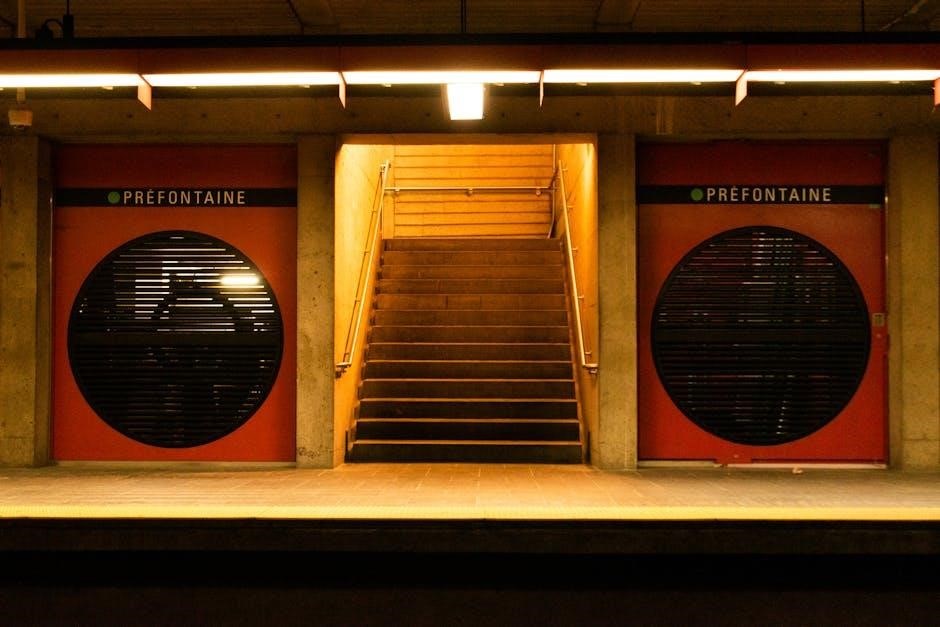
Montreal’s Underground City, known as RESO, is a vast network of tunnels and passageways connecting key locations like shopping malls, museums, and hotels. Spanning 32 kilometers, it offers all-weather accessibility, serving over 500,000 daily users and showcasing Montreal’s urban innovation.
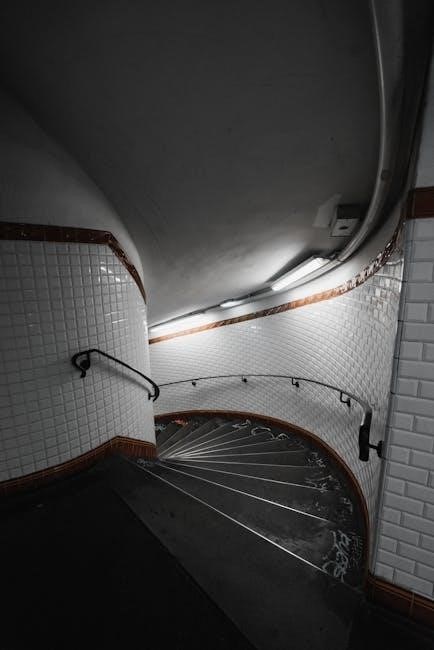
History of the Underground City
The Montreal Underground City began construction in 1962, with the first interconnected sections laid. It expanded significantly with the subway system’s launch in 1966. Over time, it grew into the world’s largest underground network, covering 32 kilometers and connecting key downtown areas, reducing traffic and enhancing pedestrian accessibility year-round.
Construction Start in 1962
The construction of Montreal’s Underground City began in 1962, marking the start of a revolutionary urban development project. This initial phase focused on creating interconnected passageways beneath the city’s downtown core, aiming to alleviate street-level congestion and provide a climate-controlled environment for pedestrians. The early stages involved building tunnels and connecting key buildings, laying the foundation for what would become the world’s largest underground network. By 1966, the integration of the subway system further enhanced the network’s functionality, making it a seamless part of Montreal’s infrastructure.
Integration with the Subway System

The integration of Montreal’s Underground City with its subway system in 1966 revolutionized urban mobility. By connecting the RESO network directly to metro stations, the city ensured seamless transitions between underground pathways and public transport. This strategic integration allowed pedestrians to navigate the city without exposure to harsh weather conditions, enhancing convenience and safety. The subway system’s extensive reach complemented the Underground City’s vast network, creating a cohesive transportation hub. Today, this integration remains a cornerstone of Montreal’s urban design, supporting over 500,000 daily users and fostering a connected, efficient cityscape.
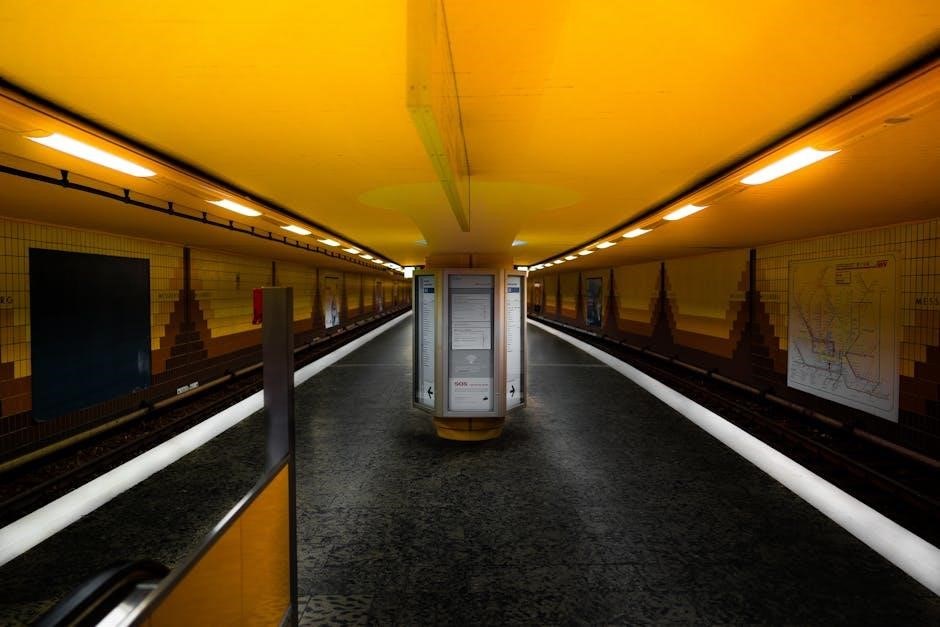
Key Features of the Underground City
Montreal’s Underground City, or RESO, is a sprawling network of tunnels and passageways spanning 32 kilometers. It features unique architecture, extensive connectivity, and all-weather accessibility, integrating seamlessly with the subway system to serve millions annually.
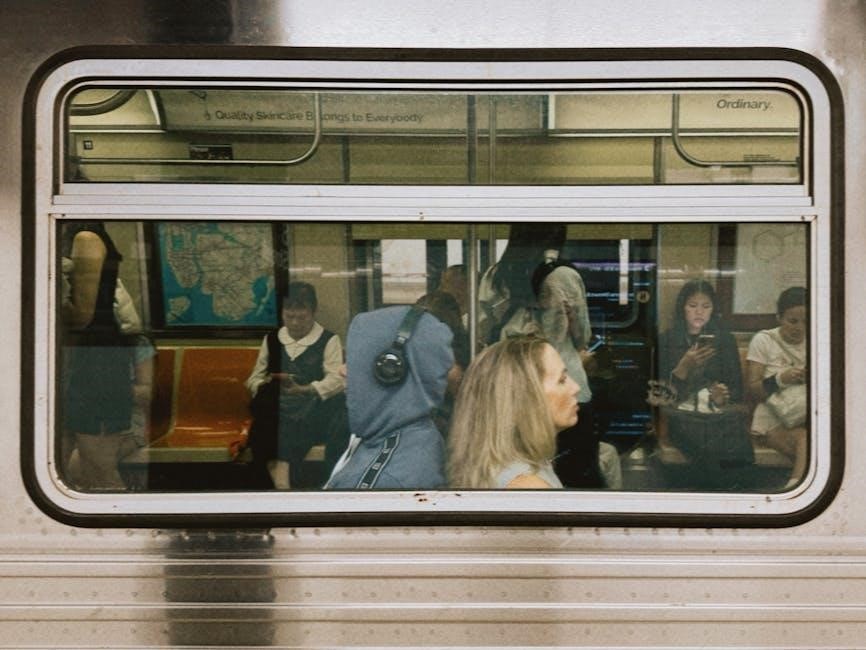
Size and Extent
Montreal’s Underground City, known as RESO, spans an impressive 32 kilometers of interconnected tunnels and passageways. Covering over 4 million square meters, it is one of the largest underground networks in the world. This vast system links together shopping malls, universities, office towers, hotels, and cultural venues, creating a seamless pedestrian environment. The network stretches across downtown Montreal, with key connections at major hubs like Complexe Desjardins and the Palais des congrès. Its sheer scale allows residents and visitors to navigate the city without braving harsh weather conditions, making it a vital part of Montreal’s infrastructure. The extensive reach of RESO ensures that nearly every major downtown destination is accessible via its tunnels, showcasing the city’s commitment to urban connectivity and convenience. This massive underground system is a defining feature of Montreal, reflecting its innovative approach to urban planning and design.
Unique Architectural Elements
Montreal’s Underground City, or RESO, boasts distinctive architectural elements that set it apart from other subterranean networks. The system seamlessly integrates modern and historic buildings, creating a visually diverse environment. Many sections feature large windows, skylights, and open spaces, providing natural light and a sense of connection to the surface. The network also incorporates public art installations and unique design elements, such as intricate mosaics and contemporary sculptures, adding to its aesthetic appeal. Each building within the RESO network has its own architectural style, reflecting Montreal’s cultural diversity and historical evolution. This blend of functionality and artistic expression makes the Underground City not just a practical transportation hub but also a cultural and architectural landmark. The innovative use of space and design ensures that the RESO network is both functional and visually striking, enhancing the overall experience for its users.
Connectivity and Access Points
The Montreal Underground City, or RESO, excels in connectivity, with over 120 external entrances and numerous indoor access points. These entrances are strategically located across downtown Montreal, ensuring easy access to the network from almost any location. Many access points are situated near major landmarks, office buildings, and public transit stations, making it simple for residents and visitors to navigate the city without braving the elements. The network is particularly well-integrated with Montreal’s subway system, allowing seamless transitions between underground and surface-level transportation. Key access points include major shopping centers like the Montreal Eaton Centre and Complexe Desjardins, as well as cultural venues such as the Palais des congrès de Montréal. Clear signage throughout the network helps users orient themselves, while maps and digital kiosks provide additional guidance. This extensive connectivity ensures that the Underground City remains a convenient and efficient way to explore Montreal, regardless of the weather or time of day.

How to Navigate the Underground City
Navigating Montreal’s Underground City is made easy with RESO signs and detailed maps. Download the PDF map for offline use or use apps like Moovit for real-time guidance. Familiarize yourself with key landmarks and stay alert in busy areas to avoid getting lost.
Understanding RESO Signs and Maps
The RESO signs and maps are essential tools for navigating Montreal’s Underground City. RESO, short for “network” in French, refers to the interconnected passageways and tunnels beneath the city. The signs are strategically placed throughout the network, providing clear directions to help users move seamlessly between locations. These signs include arrows, symbols, and text indicating nearby attractions, metro stations, and exits. Additionally, detailed maps are available at key points, such as major intersections and near metro stations, offering a visual guide to the vast network.
The maps are designed to be user-friendly, with color-coded sections representing different areas of the city. They highlight shopping malls, museums, hotels, and other important landmarks. Digital versions of these maps, including PDF formats, can be downloaded for offline use, ensuring accessibility even without internet. Understanding the RESO signs and maps is crucial for first-time visitors, as they provide a clear pathway through the extensive underground network.
By familiarizing yourself with these resources, you can efficiently explore Montreal’s Underground City, ensuring a stress-free experience while discovering its many attractions. The combination of physical signs and downloadable maps makes navigation straightforward, even for those unfamiliar with the city.
Popular Navigation Apps
Navigating Montreal’s Underground City is made easier with the help of popular navigation apps. One of the most widely used apps is Moovit, which offers a downloadable offline map of Montreal’s Downtown and Underground City. This app provides real-time updates, route planning, and step-by-step directions, ensuring users can move seamlessly through the RESO network. Another useful tool is the official STM (Société de transport de Montréal) app, which includes an interactive map of the metro and underground connections, helping users plan their journeys efficiently.
These apps are particularly helpful for visitors unfamiliar with the extensive network. They highlight key landmarks, shopping centers, and transit points, making it easier to explore the Underground City. With features like offline access and user-friendly interfaces, these navigation apps are indispensable for anyone looking to make the most of their time in Montreal’s subterranean wonderland.
By downloading these apps, users can navigate the Underground City with confidence, ensuring they never miss a connection or attraction. The integration of transit information and maps into these platforms creates a seamless experience for both locals and tourists alike.
Tips for Not Getting Lost
Navigating Montreal’s Underground City can be overwhelming due to its vast network, but with the right strategies, visitors can avoid getting lost. First, it’s essential to familiarize yourself with the RESO signs located throughout the tunnels. These signs provide clear directional information and help pinpoint your location within the network. Additionally, carrying a physical or digital copy of the Montreal Underground City map is highly recommended. The map outlines key landmarks, shopping centers, and transit points, serving as a reliable guide.
Another useful tip is to identify major reference points, such as large malls or metro stations, as these are well-marked and can serve as anchor locations. Using GPS-enabled apps like Moovit or the STM app can also provide real-time navigation assistance. Furthermore, taking note of distinctive architectural features or signage can help orient yourself within the network. Lastly, asking for directions from locals or information booths is always a good idea if you feel disoriented.
By combining these strategies, visitors can confidently explore the Underground City, ensuring a smooth and enjoyable experience while discovering Montreal’s hidden gems.

Popular Attractions Accessible via the Underground City
The Underground City connects major attractions like shopping malls, museums, and cultural venues, making it easy to explore Montreal’s highlights without braving the weather. Key spots include the iconic Eaton Centre, Place des Arts, and the Palais des Congrès.
Shopping Malls and Commercial Centers
Montreal’s Underground City is a shopper’s paradise, linking some of the city’s most prominent shopping malls and commercial centers. The network provides seamless access to iconic destinations like the Montreal Eaton Centre, a bustling hub with over 160 stores and dining options. Place Ville Marie, another key location, offers a mix of retail, dining, and office spaces, all accessible via the RESO network. Complexe Desjardins, located in the heart of downtown, features a variety of shops, restaurants, and services, making it a popular stop for both locals and visitors.
The Underground City’s connectivity ensures that visitors can explore these commercial centers without braving the elements, especially during Montreal’s harsh winters. Additionally, the network’s extensive reach allows for easy navigation between malls, creating a convenient shopping experience. With its abundance of retail options and modern amenities, the Underground City is a cornerstone of Montreal’s commerce and culture, attracting millions annually.
Museums, Galleries, and Cultural Venues
Montreal’s Underground City offers convenient access to a variety of museums, galleries, and cultural venues, making it a hub for art and history enthusiasts. The RESO network connects to iconic institutions such as the Montreal Museum of Contemporary Art, where visitors can explore cutting-edge exhibitions. Similarly, the McCord Museum, showcasing Canadian history and culture, is just a short walk through the underground tunnels.
The Underground City also links to the Palais des congrès de Montréal, a vibrant venue hosting cultural events, exhibitions, and conferences. This seamless connectivity allows visitors to navigate between these cultural landmarks without exposed to the elements, especially during Montreal’s cold winters. The network’s design ensures that access to these spaces is efficient and enjoyable, fostering a rich cultural experience for residents and tourists alike.
By integrating cultural attractions into its extensive network, the Underground City highlights Montreal’s commitment to preserving and celebrating its artistic and historical heritage. This unique feature makes it a must-visit destination for anyone interested in exploring the city’s cultural treasures.
Hotels and Accommodations
Montreal’s Underground City, or RESO, provides seamless access to numerous hotels and accommodations, making it a convenient option for travelers. Many prominent hotels, such as the Fairmont The Queen Elizabeth and the InterContinental Montreal, are directly connected to the network, allowing guests to explore the city without braving the elements.
Visitors can easily navigate from their hotels to shopping centers, restaurants, and cultural venues through the underground tunnels. This connectivity is particularly advantageous during Montreal’s harsh winters, offering a warm and efficient way to move around the city. Additionally, the proximity of hotels to public transit systems within the RESO network ensures that travelers can reach their destinations quickly and effortlessly.
The integration of hotels into the Underground City emphasizes Montreal’s focus on creating a comfortable and accessible urban environment. Whether for business or leisure, staying in a hotel connected to the RESO network enhances the overall travel experience, making it a preferred choice for many visitors to Montreal.

Practical Uses of the Underground City
Montreal’s Underground City serves as a vital transportation and commercial hub, providing all-weather access to shops, offices, and metro stations, while reducing traffic and enhancing safety for over 500,000 daily users, showcasing its economic and social importance.
All-Weather Accessibility
The Montreal Underground City, or RESO, offers unparalleled all-weather accessibility, making it a lifeline for residents and visitors year-round. During harsh Canadian winters, the network provides a warm and sheltered environment, allowing pedestrians to move freely without exposure to snow or freezing temperatures. Similarly, in the summer, it offers a cool escape from the heat. This extensive system ensures that key areas like shopping malls, office buildings, and metro stations remain accessible regardless of weather conditions. The underground tunnels are climate-controlled, maintaining a comfortable temperature throughout the year. This feature not only enhances user comfort but also supports the local economy by keeping businesses thriving during extreme weather. The RESO network’s all-weather design is a testament to Montreal’s innovative urban planning, ensuring connectivity and convenience for over 500,000 daily users. Whether rain, snow, or heat, the Underground City remains a reliable and comfortable way to navigate downtown Montreal.
Safety and Security
The Montreal Underground City prioritizes safety and security, ensuring a protected environment for its millions of annual visitors. The network is equipped with 24/7 surveillance, emergency exits, and well-lit passageways to maintain visibility and safety. Security personnel are stationed throughout the tunnels, especially in high-traffic areas, to quickly respond to any incidents. Additionally, the underground system is designed with clear signage and maps, helping users navigate without confusion. This focus on safety contributes to its reputation as a secure and reliable transportation and shopping hub. The integration of the metro system further enhances security, with trained staff and police presence ensuring a safe commute. Overall, the Underground City’s emphasis on safety and security makes it a trusted space for both locals and tourists to explore and travel comfortably.
Economic Impact
The Montreal Underground City has a significant economic impact, supporting the city’s commercial and business activities. By connecting office towers, shopping centers, and hotels, it boosts foot traffic and retail sales, particularly during winter when outdoor activity declines. The network enhances accessibility for workers and shoppers, reducing the need for vehicular transportation and decreasing traffic congestion. This interconnected system also attracts businesses and investors, as it provides a convenient and efficient environment for commerce. Additionally, the Underground City is a major tourist attraction, drawing millions of visitors annually and contributing to the local economy through spending in shops, restaurants, and cultural venues. Its role in facilitating easy movement of people supports the overall economic vitality of Montreal, making it a cornerstone of the city’s infrastructure and a key driver of economic growth.
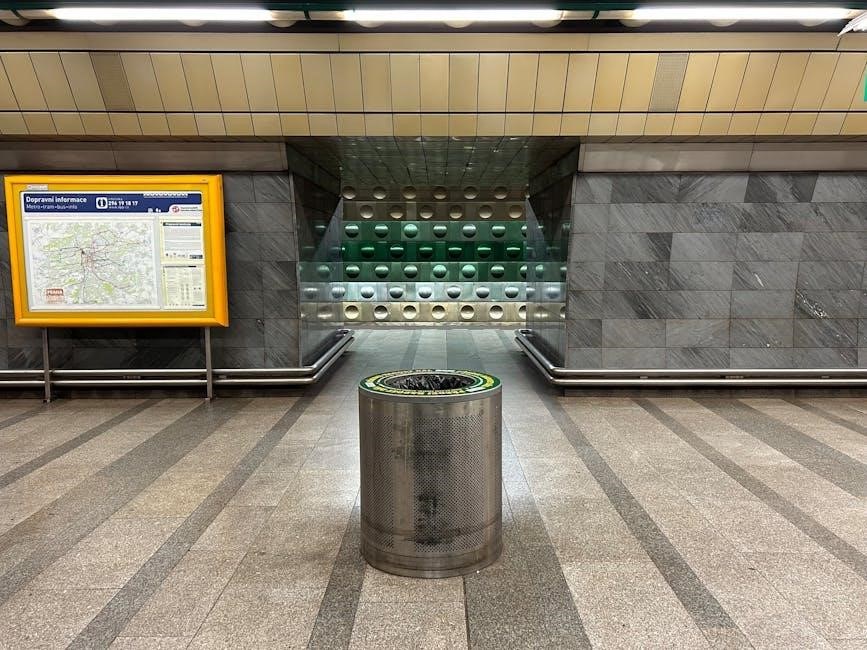
Obtaining the Montreal Underground City Map
Access the Montreal Underground City map by downloading the PDF version online or obtaining a physical copy from metro stations. The map is provided by the STM and is available for purchase by mail, ensuring easy navigation of the RESO network.

Downloading the PDF Version
Downloading the PDF version of the Montreal Underground City map is a convenient option for visitors and residents alike. The map is available on the STM (Société de transport de Montréal) website and can be accessed free of charge. Simply visit the STM website, navigate to the section dedicated to the RESO network, and click on the link to download the PDF. This version is ideal for offline use, ensuring you can navigate the underground city without an internet connection. Additionally, third-party apps like Moovit offer downloadable PDF maps that integrate metro and underground city routes, making it easy to plan your journey. The PDF map is detailed, featuring all tunnels, stations, and key attractions, and is compatible with most devices. This resource is especially useful for tourists and commuters seeking to explore Montreal’s vast underground network efficiently. By downloading the PDF, you can carry the map with you wherever you go, ensuring seamless navigation through the RESO system.